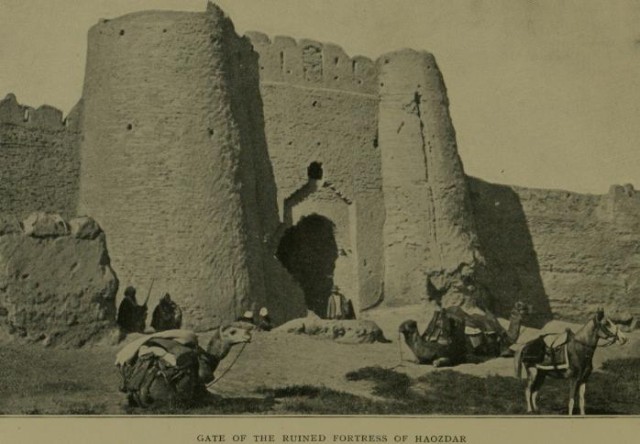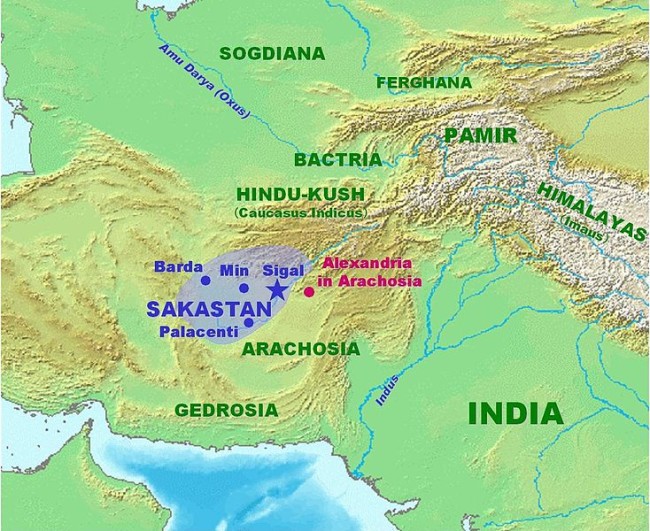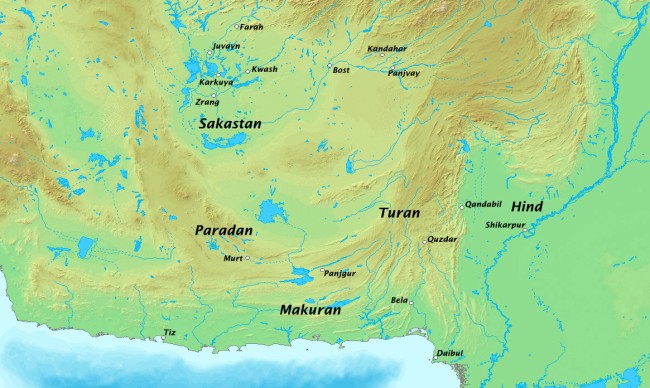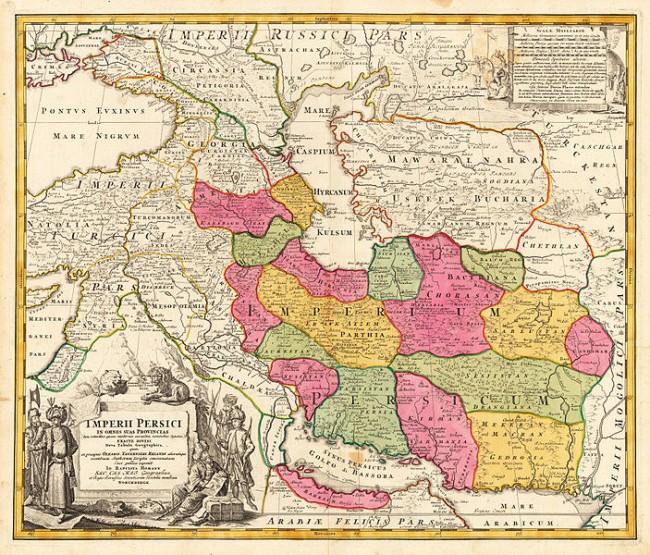
| SISTAN
The gates of Haozdar, in Sistan Sistan, known in ancient times as Sakastan ("the land of the Saka"), is a historical and geographical region in present-day Eastern Iran (Sistan and Baluchestan Province) and Southern Afghanistan (Nimruz, Helmand, Kandahar). Largely desert, the region is bisected by the Helmand River, the largest river in Afghanistan, which empties into the Hamun Lake that forms part of the border between the two countries.
Etymology
:
The more ancient Old Persian name of the region - prior to Saka dominance - was zaranka "waterland". This older form is also the root of the name Zaranj, capital of the Afghan Nimruz Province.
Encyclopædia Iranica says "The name of the country and its inhabitants is first attested as Old Persian z-r-k (i.e., Zranka) in the great Bisotun inscription of Darius I, apparently the original name. This form is reflected in the Elamite (Sir-ra-an-qa and variants), Babylonian (Za-ra-an-ga), and Egyptian (srng or srnk) versions of the Achaemenid royal inscriptions, as well as in Greek Zarángai, Zarangaîoi, Zarangiane (Arrian; Isidore of Charax), and Sarángai (Herodotus) and in Latin Zarangae (Pliny). Instead of this original form, characterized by non-Persian z (perhaps from proto-IE. palatal *y or *yh), in some Greek sources (chiefly those dependent upon the historians of Alexander the Great) the perhaps hypercorrect Persianized variant (cf. Belardi, p. 183) with initial d-, *Dranka (or even *Dranga), reflected in Greek Drángai, Drange, Drangene, Drangi(a)ne (Ctesias; Polybius; Strabo; Diodorus; Ptolemy; Arrian; Stephanus Byzantius) and Latin Drangae, Drangiana, Drangiani (Curtius Rufus; Pliny; Ammianus Marcellinus; Justin) or Drancaeus (Valerius Flaccus, Argonautica 6.106, 6.507) occurs."
In the Shahnameh, Sistan is also referred to as Zabulistan, after the region in the eastern part of present-day Afghanistan. In Ferdowsi's epic, Zabulistan is in turn described to be the homeland of the mythological hero Rostam.
History
:
Map of Sakastan in c. 100 BC In prehistoric times, the Jiroft Civilization covered parts of Sistan and Kerman Province (possibly as early as the 3rd millennium BC). It is best known from excavations of the archaeological site of Shahr-i Sokhta, a massive third millennium BC city. Other smaller sites have been identified in the region in surveys by American archaeologists Walter Fairservis and George Dales. The site of Nad-i Ali in Afghan Sistan has also been claimed to date from the Bronze Age (Benseval and Francfort 1994).
Later the area was occupied by Aryan tribes related to the Indo-Aryans and Iranian peoples. Eventually a kingdom known as Arachosia was formed, parts of which were ruled by the Medean Empire by 600 BC. The Medes were overthrown by the Achaemenid Persian Empire in 550 BC, and the rest Arachosia was soon annexed. The archaeological site of Dahan-i Gholaman was a major Achaemenid centre. In the 4th century BC, Macedonian king Alexander the Great annexed the region during his conquest of the Persian Empire and founded the colony of "Alexandria in Arachosia" (modern Kandahar). The Greek city of Bost, now encompassed in modern Lashkargah, was also developed as a Hellenistic centre.
Alexander's Empire fragmented after his death, and Arachosia came under control of the Seleucid Empire, which traded it to the Mauryan dynasty of India in 305 BC. After the fall of the Mauryans, the region fell to their Greco-Bactrian allies in 180 BC, before breaking away and becoming part of the Indo-Greek Kingdom. Indo-Parthian king Gondophares was leader of Sakastan around c. 20–10 BCE as it was part of the Indo-Parthian Kingdom which was also called Gedrosia, its Hellenistic name.
After the mid 2nd century BC, much of the Indo-Greek Kingdom was overrun by tribes known as the Indo-Scythians or Saka, from which Sistan (from Sakastan) eventually derived its name. The Indo-Scythians were defeated around 100 BC by the Parthian Empire, which briefly lost the region to its Suren vassals (Indo-Parthian) around 20 AD, before the region was conquered by the Kushan Empire in the mid 1st century AD. The Kushans were defeated by the Sassanid Persian Empire in the mid 3rd century, first becoming part of a vassal Kushansha state, before being overrun by the Hephthalites in the mid 5th century. Sassanid armies reconquered Sakastan in by 565 AD, but lost the area to the Arab Rashidun Caliphate after the mid 640s.
Sasanian
era :
Map of Sakastan under the Sasanians During his early reign, Shapur II (r. 309-379) appointed his brother Shapur Sakanshah as the governor of Sakastan. Peroz I (r. 459–484), during his early reign, put an end to dynastic rule in province by appointing a Karenid as its governor. The reason behind the appointment was to avoid further family conflict in the province, and in order to gain more direct control of the province.
Islamic
conquest :
In 650, Abd-Allah ibn Amir, after having secured his position in Kerman, sent an army under Mujashi ibn Mas'ud to Sakastan. After having crossed the Dasht-i Lut desert, Mujashi ibn Mas'ud arrived to Sakastan. However, he suffered a heavy defeat and was forced to retreat.
One year later, Abd-Allah ibn Amir sent an army under Rabi ibn Ziyad Harithi to Sakastan. After some time, he reached Zaliq, a border town between Kirman and Sakastan, where he forced the dehqan of the town to acknowledge Rashidun authority. He then did the same at the fortress of Karkuya, which had a famous fire temple, which is mentioned in the Tarikh-i Sistan. He then continued to seize more land in the province. He thereafter besieged Zrang, and after a heavy battle outside the city, Aparviz and his men surrendered. When Aparviz went to Rabi to discuss about the conditions of a treaty, he saw that he was using the bodies of two dead soldiers as a chair. This horrified Aparviz, who in order to spare the inhabitants of Sakastan from the Arabs, made peace with them in return for heavy tribute, which included a tribute of 1,000 slave boys bearing 1,000 golden vessels.Sakastan was thus under the control of the Rashidun Caliphate.
Caliphate
rule :
During the First Fitna (656–661), the people of Zarang rebelled and defeated the Muslim garrison of the city. In 658, Yazdegerd III's son Peroz III reclaimed Sistan and established a kingdom there, known in Chinese sources as the "Persian Area Command". However, in 663, he was forced to leave the region after suffering a defeat to newly established Umayyad Caliphate, who had succeeded the Rashiduns.
Saffarid
dynasty :
A year later in 1003, Sistan revolted. In response, Mahmud brought an army to suppress the revolt. Mahmud's Hindu troops sacked the mosques and churches of Zarang massacring the Muslims and Christians inside.
Nasrid
dynasty :
Mihrabanid
dynasty and its successors :
Map of the Safavid dynasty in ca. 1720, with Sistan as one of its major provinces Safavid rule lasted till 1717 except during Uzbek rule between 1524-1528 and 1578-1598 when the Hotaki dynasty conquered it. Nadir Shah reconquered in it 1727. After assassination of Nadir Shah, Sistan went under the rule of Durrani Empire in 1747. Between 1747 and 1872 Sistan was contested by Persia and Afghanistan. The border dispute between Persia and Afghanistan was solved by Sistan Boundary Mission, led by British General Frederick Goldsmid, who agreed to most of Sistan to be in Persia but the Persians won the withdrawal of the right bank of the Helmand. The countries were not satisfied.
The border was defined more precisely with the Second Sistan Boundary Commission (1903-1905) headed by Arthur Mac Mahon, who had a difficult task due to lack of natural boundaries. The part assigned Persia was included in the province of Balochistan (which took the name of Sistan and Baluchistan in 1986) being the capital Zahedan. In Afghanistan it was part of the Sistan province of Farah-Chakansur that was abolished in the administrative reorganization of 1964 to form the province of Nimruz, with capital Zaranj.
Significance
for Zoroastrians :
Archeology
:
Source :
https://en.wikipedia.org/ |



